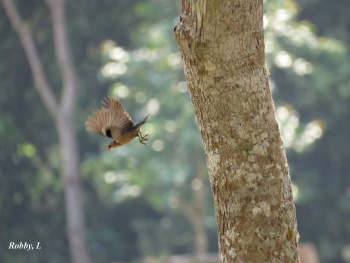Alternative name: Velvet-fronted Blue Nuthatch
- Sitta frontalis
Identification
12.5cm (5 in). A medium-small nuthatch.
- Bright red bill
- Velvety black patch on forehead
- Narrow black supercilium
- Deep violet-blue upperparts
- Whitish throat and breast
- Buff underparts
Females are similar but they lack the black supercilium. Juveniles are like adults but with a black bill.
Distribution

Photo © by appendiculata191
Phu Khiao Wildlife Reserve, Thailand, February 2011
From India east to Burma, Thailand, Indochina, southern China, Malaysia, Sumatra, Borneo, Java and the southernmost islands of the Philippines.
Common in parts of its range.
Taxonomy
Sometimes with Yellow-billed Nuthatch and Sulphur-billed Nuthatch placed in the genus Oenositta. May form a superspecies with this two species.
Subspecies
Five subspecies recognized[1]:
- S. f. frontalis in Indian Himalayas, peninsular India, Bangladesh, Sri Lanka, southern China, Burma, Thailand and Indochina
- S. f. saturatior on the Malay Peninsula, Sumatra and Bangka
- S. f. corallipes on Borneo
- S. f. palawana on Palawan and Balabac in the western Philippines
- S. f. velata on Java
Habitat
Forests. Found in tropical rainforest, semi-evergreen hill forest, deciduous forest, pine forest and also in plantations.
Generally in lowlands but also in hills and up to 2200m.
Behaviour
Diet
Feeds on insects and spiders.
Frequents the canopy and middle story in small noisy parties or sometimes solitarily, rapidly moving up and down tree trunks while foraging. Often in mixed species flocks.
Breeding
The nest is placed in a hole in a dead branch or a tree trunk, 1 to 12m above the ground. Lays 2 to 6 eggs.
Movements
A resident species. Probably some altitudinal movements.
Vocalisation
Recording by Alok Tewari
Sat Tal Forest, Alt. 5500 ft., Uttarakhand Himalayas, India, October-2018
Call given by a male foraging, late morning, as it moved around.
References
- Clements, J. F., T. S. Schulenberg, M. J. Iliff, D. Roberson, T. A. Fredericks, B. L. Sullivan, and C. L. Wood. 2018. The eBird/Clements checklist of birds of the world: v2018. Downloaded from http://www.birds.cornell.edu/clementschecklist/download/
- Del Hoyo, J, A Elliott, and D Christie, eds. 2008. Handbook of the Birds of the World. Volume 13: Penduline-tits to Shrikes. Barcelona: Lynx Edicions. ISBN 978-8496553453
- Birds of Indian Subcontinent : Richard Grimmett et al, 2nd edition, 2011
Recommended Citation
- BirdForum Opus contributors. (2024) Velvet-fronted Nuthatch. In: BirdForum, the forum for wild birds and birding. Retrieved 28 April 2024 from https://www.birdforum.net/opus/Velvet-fronted_Nuthatch
External Links
GSearch checked for 2020 platform.1





